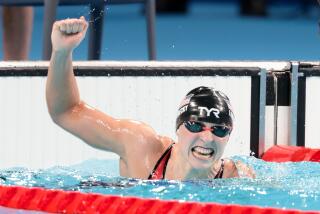Cox’s Swim Has Been 16 Years in the Making
- Share via
Lynne Cox says of her plan to swim the icy Bering Strait, “It’ll definitely be the toughest swim I’ve ever done . . . the farthest I’ve ever reached.”
That’s saying a lot. Cox, 30, has spent 16 years building up to it. En route to earning a history degree from UC Santa Barbara in 1980, she created some of her own. Here’s a summary of her long-distance efforts, with her flash recollections:
1971--Catalina; 26 miles (straight-line distance, not allowing for currents): “That was with a group of kids. We had to stay at the same rate of speed, and that was an incredibly frustrating swim because we were getting so cold treading water waiting for each other.”
1972--English Channel; 21 miles, set record, for men and women, of 9 hours 57 minutes: “That was like a childhood dream, to do that. It was almost overwhelming . . . fishermen out there waving and saying in French, ‘There’s a channel swimmer.’ At the same time, it was real disappointing. You’re 16. What do you do from here?”
1973--English Channel; reclaimed record at 9:36, since broken: “You have the added pressure now of not only making it but to break the record or you’ve failed. After I did it the second time I decided there are people that get hooked on the channel and go back every year, whether they’ve made it or not, just to try to do it again. There had to be some way to go beyond that.”
1974--The Nile; stopped after swimming 15 miles in 5 hours 30 minutes: “One of my failures. I’d had dysentery for a week and wound up in the hospital afterward. Egypt and Israel were having problems at the time, and we swam through barrels that were placed in the river to keep mines from floating down. I remember mud, slime, dead rats and raw sewage. Not one of my favorite swims.”
1974--Catalina, after her older brother David broke the island-to-mainland record: “I went the other way--from the mainland to the island--and broke the record (8:48, since broken).”
1975--Cook Strait, between North and South islands of New Zealand; first woman; 10 miles, 12:02:30: “At that point it was my toughest swim. To be in the water for five hours and be farther from the finish than when you started, with conditions getting worse, is terrible. There was a Captain John Brown who pulled one of those large ferries alongside and shielded us from the wind and hoisted the American flag. The following day, when I was flying back from the South Island, the stewardess said her pilot had been flying off course all day so they could watch our progress.”
1976--Straits of Magellan, Chile; 4.5 miles miles, 1 hour, water temperature 42 degrees: “It was so rough at the end of the swim that the boat couldn’t land, and we had to go back through the straits in a full-blown gale.” Also, Coach John Sonnichsen’s camera froze, and her guide boat took the wrong course, while she took the proper one.
1976--Oresund, from Denmark to Sweden (12 miles, 5:19:45), and Skagerrak, from Norway to Sweden (15 miles, 6:16); first person: “Jellyfish. Jellyfish as big as trash can lids. They’re real red, like red Jell-O, but with different colors merging, like a tequila sunrise, and with long tentacles that just burn like heck. They have yellow ones that are the color of an egg yolk and smaller ones that are white with a cross in the center that don’t sting.”
1977--Aleutian Islands, series of three short, cold-water swims in waters of 44 to 50 degrees: “One of those things you build up for, and it was no big deal.”
1978--Cape of Good Hope, South Africa; 10 miles, 4:30; water temperature from 56 to 76 degrees: “Sharks. Waves. The waters were too rough to use shark cages, but I won’t use ‘em anyway because you’re cheating. We had to fight our way out through a 15- to 20-foot surf. When we were about 400 yards from shore a shark came out of the kelp for me. One of the divers went down to shoot it with a spear gun. He told me later it was an 11-foot bronze whaler, a very aggressive shark.
“They told me before I made the swim that sharks always bump their victims before they bite ‘em. Well, the wind was blowing so hard that it kept pushing the Zodiac (rubber boat) onto me. So I was practically jumping out of the water all the way around.”
1979--Jogashima Island, Japan; 7 miles, 3:00; in conjunction with lecture tour of Japanese universities: “A piece of cake. They were supposed to swim with me, but it got a little choppy, and then everyone else got out when it got cold and dark.”
1983--Southern Alps swims of New Zealand lakes; water temperature mid-40s: “Cold freshwater feels different than cold saltwater. It seems like you get cold a lot faster in fresh water. I’ve been wondering why that is for a long time.”
1984--Swims Across America, a series of 14 lakes and waterways, including the Golden Gate but not the Mississippi: “That was basically a test for the around-the-world swims. (The Mississippi) was too dirty, and they have what they call boils there where the rocks form sudden depressions that can suck you under. So I decided I’d pass.”
1985--Swims Around the World in 80 Days, including Iceland, Straits of Gibraltar and Messina, The Bosporus, Lake Kunming in China, Glacier Bay in Alaska and around the Statue of Liberty: “A marathon within a marathon. A major swim every 4 to 7 days . . . getting the sponsors and the boats along the way, making the swim and rushing off to the next one. Exhausting.”
More to Read
Sign up for The Wild
We’ll help you find the best places to hike, bike and run, as well as the perfect silent spots for meditation and yoga.
You may occasionally receive promotional content from the Los Angeles Times.






